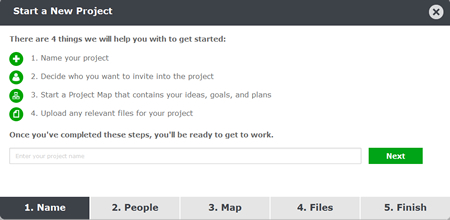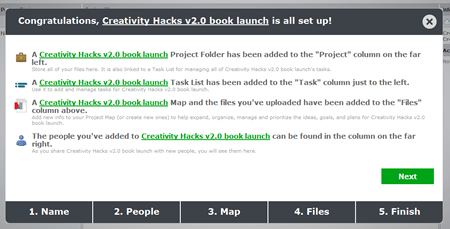Mindjet, the developer of the popular MindManager mind mapping software, recently announced the debut of ProjectDirector, the next step in the evolution of its small team project collaboration platform. It provides more unified access to your team’s projects, tasks, files and people in a simplified interface.
Get started with new projects faster
In the past, Mindjet’s collaboration toolset, called Connect, provided access to team project assets, such as mind maps, task information and files online, but they could only be accessed in separate views. With the launch of ProductDirector, Mindjet introduces a reorganized interface that is designed to help new users get started faster with it. “We did extensive user research on our Connect collaboration environment, and learned that people wanted more help in getting started,” explains Mindjet chief product officer Blaine Matthieu. “The new interface and tools we’ve provided make it easier to get people on-boarded and productive with it quickly.”
 To create a new project, you simply click on the prominent “plus” button in the upper left corner of the ProjectDirector workspace. A new “project wizard” appears (see screenshot at right), which walks you through a simple step-by-step process to add people, a project mind map and any relevant files to your project. Team members can be invited via your contact list in ProjectDirector or via e-mail. The wizard gives you access to 12 mind map templates that cover common business tasks, such as strategic planning and problem solving, or you can create a new, blank mind map to begin collecting your information and ideas.
To create a new project, you simply click on the prominent “plus” button in the upper left corner of the ProjectDirector workspace. A new “project wizard” appears (see screenshot at right), which walks you through a simple step-by-step process to add people, a project mind map and any relevant files to your project. Team members can be invited via your contact list in ProjectDirector or via e-mail. The wizard gives you access to 12 mind map templates that cover common business tasks, such as strategic planning and problem solving, or you can create a new, blank mind map to begin collecting your information and ideas.
 Once you have finished adding information to the wizard, ProjectDirector sets it up and displays a summary of where to find its assets – including convenient links to their locations (see screenshot at right). As a final step, it then invites you to “work on the map” for your project, manage the task list, work with the files or add more people to it.
Once you have finished adding information to the wizard, ProjectDirector sets it up and displays a summary of where to find its assets – including convenient links to their locations (see screenshot at right). As a final step, it then invites you to “work on the map” for your project, manage the task list, work with the files or add more people to it.
Based on my experience in working with it, I believe ProjectDirector succeeds in providing a guided learning environment that should get new users set up and running in a minimum of time, with little or no learning curve.
Social task management
The redesigned ProjectDirector interface features 4 tabs across the top: Projects , Tasks, Library (where mind maps and any other files you have uploaded) and Contacts. Tasks provides you with access to social task management, with stream-like views of all tasks associated with the tasks assigned to each project. Clicking on an existing task opens up a pane that displays all of its information, including to whom it has been assigned, anyone “following” its status, start, end and progress and more. This view will be quite familiar to previous users of Connect, right down to the default set of tasks that invite you to get started and prompt you at each step to learn how to utilize it (see screen shot). A vertical pane on the left side of the screen makes it easy to switch between the task lists of multiple projects, search for tasks or switch to the profiles of your team members.
Library now connects with cloud-based file storage services
Library provides a multi-paneled list view of all of your mind maps and other files you have uploaded to your project workspace. Like tasks, this view hasn’t changed much, since the main thrust of ProjectDirector is to do a better job of tying all of the pieces of Mindjet’s online platform together more tightly and to help team members get started with them faster. Previous users of Mindjet’s Connect collaboration tool will find that all of their files and projects have been moved here.
One of the limitations of Connect (and Catalyst before it) was that its file library was a proprietary repository, which users had to maintain in addition to any other cloud-based storage services they may have been using. With the debut of ProjectDirector, Mindjet has eliminated this shortcoming. It now integrates with popular online file management tools like Dropbox, Box.net, Skydrive and Google Drive, giving users immediate access to all of the files they have stored there. This is a big plus!
Finally, Contacts, as its name implies, enables you to view information about each of your collaborators. Contacts can have full access to create and edit tasks and maps within ProjectDirector, or they can be designated as “guests” – who only have read-only access to projects and content.
A more integrated platform than ever before
ProjectDirector’s task tool features real-time, two-way integration with Mindjet’s Windows, Mac and Web-based mind mapping tools. Mindjet reports that new apps will be released for iOS and Android to support this enhanced collaboration platform during the next several months. Frequently, the development of the Mac version of MindManager has lagged behind that of the Windows version. It’s nice to see that Mindjet has made a commitment to equally support both platforms with this new collaboration toolset.
Pricing
ProjectDirector is available in packages of 5, 20 and 50 members ($59, $199 and $399 per month, respectively). This is for users who have full rights to create projects and contribute to them. In addition, Mindjet is allowing for an unlimited number of guests, who have read-only access. MindManager is also available as a stand-alone software program, for those people who simply want to create mind maps and aren’t going to use Mindjet’s suite of online tools for project management.
For more information on ProjectDirector, please visit the Mindjet website.


Leave a Reply